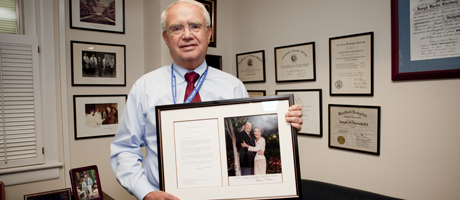Nearly 30 years ago, GW physician Joseph Giordano headed the trauma team that saved Ronald Reagan’s life.
By Rachel Muir
On March 30, 1981, Ronald Reagan was just 69 days into his presidency. Shortly before 2:30 p.m., the president was leaving the Washington Hilton, where he had just given a speech to union representatives.
As Mr. Reagan waved to the crowd gathered outside, John Hinckley Jr. pulled out a gun and fired six times. The last bullet ricocheted off the presidential limousine, hitting the president under the left arm. The bullet penetrated Mr. Reagan’s lung and lodged an inch from his heart.
Three others, including White House press secretary James Brady, a police officer and a Secret Service agent, were also wounded in the assassination attempt.
Joseph Giordano, a surgeon and head of the trauma team at George Washington University Hospital, was examining a patient on the sixth floor of the hospital when he was paged to the emergency room stat.
“A stat page was very rare, so I was curious,” says Dr. Giordano, who retires from GW this week after 42 years. “I walked into the ER and there were all these people there, then I saw the president lying on a gurney.”
The president’s blood pressure was very low, and his pulse was barely detectable. After walking into the hospital on his own, Mr. Reagan had collapsed in the lobby.
“He was seriously injured,” says Dr. Giordano. “I think he was close to dying.”
The trauma team, led by Dr. Giordano, found the gunshot wound on the side of the president’s chest. “Until then, no one knew that the president had been shot,” he says. Instead the Secret Service agents and the president himself believed the injury was the result of a broken rib caused when an agent pushed him into the limousine to avoid the gunfire.
The team worked quickly to resuscitate Mr. Reagan, giving him blood and fluids and inserting a chest tube to drain blood from his lungs.
Dr. Giordano says he wasn’t overly nervous but did tell himself, “Boy, this better go well.”
Mr. Reagan was conscious the whole time the trauma team was treating him. The conversation with the doctors was mostly “matter of fact,” but despite his obvious pain the president cracked a few jokes.
“President Reagan said to me, ‘I hope you’re all Republicans,’ and I replied, ‘Today, we’re all Republicans,’” Dr. Giordano says. “I’m not a Republican, but I thought for this one day I could be one.”
It took about 35 minutes to stabilize the commander in chief, who was then taken to the operating room where he underwent surgery to remove the bullet.
“I think it was important that he came here right away,” says Dr. Giordano. Mr. Reagan’s motorcade had started to head to the White House after the shooting but when the president coughed up blood the Secret Service insisted on taking him to a hospital and GW was the closest. The other shooting victims were also treated at GW.
“It was also important that we had a trauma team in place,” says Dr. Giordano. Trauma teams, groups of six or seven physicians including surgeons and anesthesiologists who each have a role in responding to emergencies, were relatively new in the early 1980s.
Mr. Reagan remained hospitalized at George Washington for about a week, and he recovered “uneventfully,” says Dr. Giordano.
But the aftermath for Dr. Giordano and the hospital was anything but uneventful.
“It’s affected my life ever since,” he says. The hospital received a “huge” amount of publicity. “It really put GW on the map, and it had a very positive impact on all of us who took care of the president.”
Dr. Giordano’s wall is covered with accolades he received for his efforts to save Mr. Reagan’s life, including a citation from the Italian government and a letter from first lady Nancy Reagan.
Dr. Giordano calls his four decades at GW “very rewarding.” He first came to the university for a surgical residency in 1968 and has served as chair of the Department of Surgery for the past 18 years.
He counts the strength of the surgical program at GW and the success of Medical Faculty Associates as some of his points of pride from his time at the university. Dr. Giordano says he will spend more time with his family and help organize medical missions to Guatemala during his retirement.
But, he says, in the public eye, nothing will eclipse that day in March nearly three decades ago.
“It was a real moment in history,” says Dr. Giordano. “I feel grateful I was there and part of it.”
Comments? Criticism? The conversation continues. We welcome reactions, commentary and story recommendations on our Facebook page.


